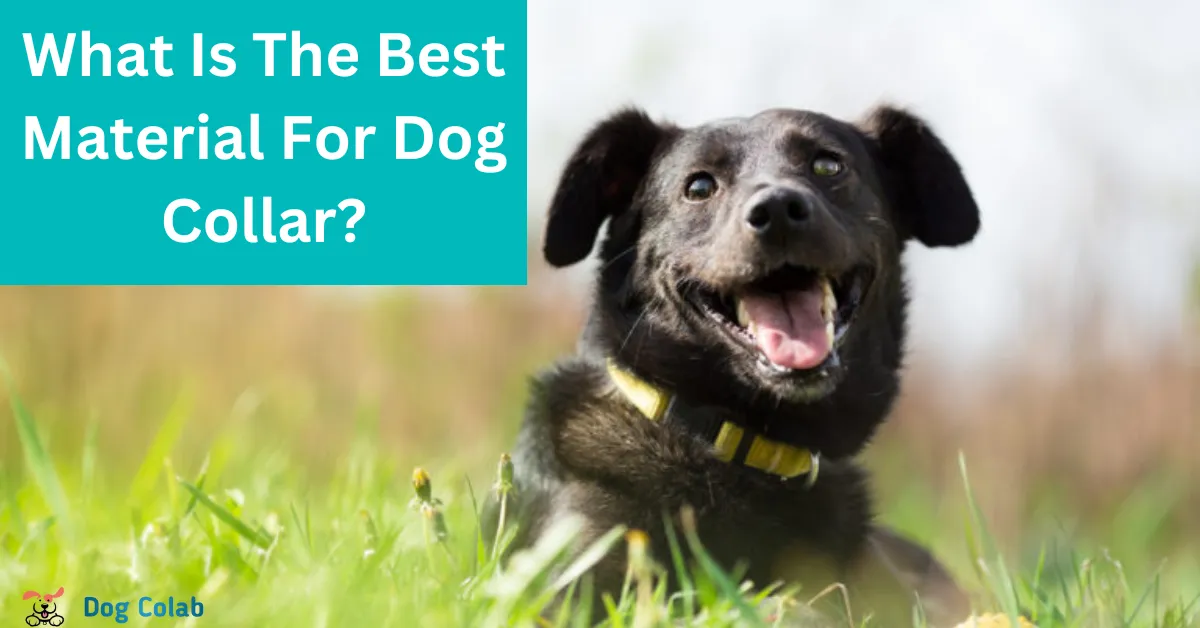A dog collar is an essential accessory for every canine companion. It not only serves as a means to attach a leash for walks and training but also holds identification tags that help in the event of your dog getting lost. When selecting a dog collar, it is crucial to consider the material from which it is made.
The right material can ensure your dog’s comfort, safety, and overall well-being. So, In this blog post, we will discuss what is the best material for dog collar, their benefits, and how to make an informed choice based on your dog’s needs and lifestyle.
What Is the Purpose Of A Dog Collar?
The primary purpose of a dog collar is to serve as an accessory that can hold identification tags and provide a point of attachment for a leash. However, dog collars also serve various other functions, such as:

- Identification: Collars often have a tag that includes the dog’s name, owner’s contact information, and sometimes medical information. This helps in reuniting a lost dog with its owner quickly.
- Control and Training: A collar allows for easy control and guidance of the dog while walking on a leash. It provides a point to attach a leash, which helps in preventing the dog from running off, especially in busy or public areas. Collars can also aid in training by allowing gentle corrections or guidance.
- Safety: Some collars come with reflective materials that increase the visibility of the dog in low-light conditions, enhancing safety during walks or nighttime activities.
- Preventing Escapes: Collars can be equipped with a quick-release buckle or breakaway mechanism that allows the collar to come off if it gets caught on an object, reducing the risk of injury or strangulation.
- Fashion and Personalization: Collars come in a wide variety of styles, colors, and materials, allowing pet owners to express their dog’s personality or their own style preferences.
- Medical and Identification Purposes: Medical collars, also known as “Elizabethan collars” or “E-collars,” are cone-shaped collars that prevent dogs from licking or chewing at surgical incisions, injuries, or irritations. These collars are commonly used during post-operative recovery.
What Is the Best Material For Dog Collar?
The choice of the best dog collar material depends on factors such as your dog’s size, breed, activity level, and any specific requirements. Here are some common materials used for dog collars, along with their advantages and considerations.
1. Nylon Dog Collar
nylon dog collar material is the popular material choice due to its affordability, durability, and versatility. Nylon collars come in a wide range of colors and designs, allowing pet owners to express their dog’s personality.
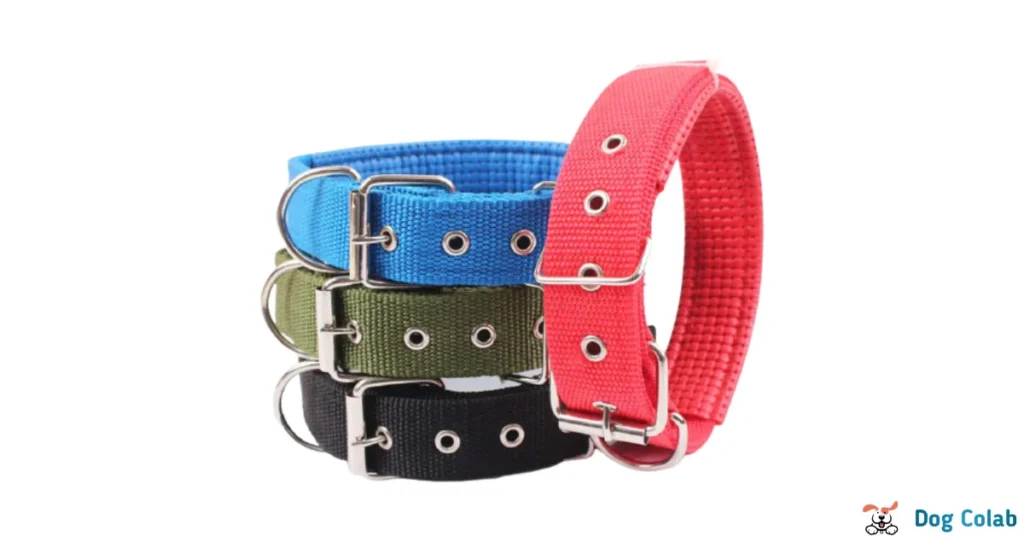
Nylon is lightweight, making it a comfortable option for dogs of all sizes. It’s also easy to clean and maintain, which is particularly beneficial for dogs that enjoy outdoor activities and may get dirty.
Nylon collars often have adjustable buckles, allowing you to find the perfect fit for your dog. Additionally, many nylon collars come with reflective dog collar material or reflective strips for improved visibility in low-light conditions, enhancing safety during walks. However, some dogs may experience skin irritation from prolonged contact with nylon.
Pros
- Durable dog collar material and long-lasting.
- Easy to clean and maintain.
- Wide variety of colors and styles.
- Affordable.
- Suitable for everyday use and active dogs.
Cons
- Can fray over time with heavy use.
- May cause irritation or rubbing if not padded or lined properly.
2. Leather Dog Collar
Leather collars are a classic and stylish choice for dogs. They are known for their durability, strength, and comfort. Genuine leather collars are known for their elegant look and a soft feel against the dog’s skin. They tend to become more comfortable over time as they mold to the dog’s neck shape.
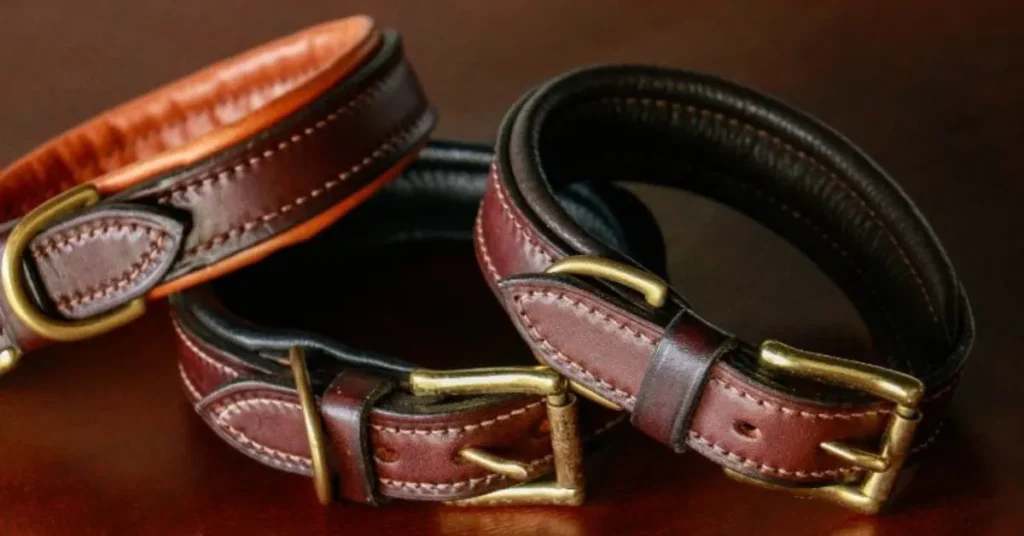
High-quality leather is the most comfortable dog collar material and they less likely to cause skin irritation, making them suitable for dogs with sensitive skin and active dogs or those with a tendency to chew. They are generally more expensive than nylon collars and require occasional maintenance with leather conditioners to keep them in good condition.
However, it’s crucial to ensure that the leather is well-tanned and well-constructed to prevent issues like cracking or stretching.
Pros
- Aesthetic appeal and quality look.
- Can become more comfortable over time as it molds to the dog’s neck.
- Durable and strong.
- Best dog collar material for sensitive skin as it’s less likely to cause irritation.
Cons
- Requires more maintenance to prevent drying out and cracking.
- More expensive than other materials.
3. Biothane Dog Collar
Biothane is a synthetic material that closely resembles leather in appearance but offers added benefits. It is known for its strength, weather resistance, and low-maintenance characteristics. Biothane is a waterproof dog collar material, odor-resistant, and highly durable, making it an excellent choice for dogs that enjoy outdoor activities and wet environments.
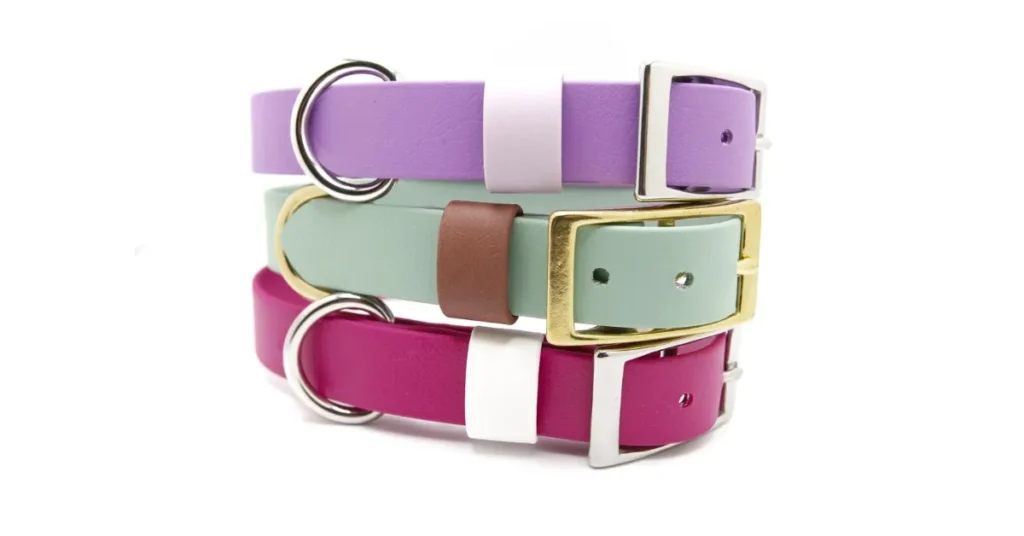
Biothane collars are easy to clean and maintain, as they do not absorb moisture or odors. They are available in various colors and are less likely to cause allergic reactions compared to some other materials.
Biothane is also resistant to fading, cracking, and stretching, ensuring a long-lasting collar that retains its aesthetic appeal.
Pros
- Waterproof and easy to clean.
- Resistant to odors and stains.
- Durable and long-lasting.
- Flexible
- Doesn’t require the same level of maintenance as leather.
- Suitable for active and water-loving dogs.
Cons
- Can be expensive.
4. Neoprene Dog Collar
Neoprene is a synthetic material commonly used in wetsuits, making it an excellent choice for water-loving dogs. Neoprene dog collars are comfortable, lightweight, and resistant to water and odor absorption. These collars are ideal for dogs that enjoy swimming or playing in the water.
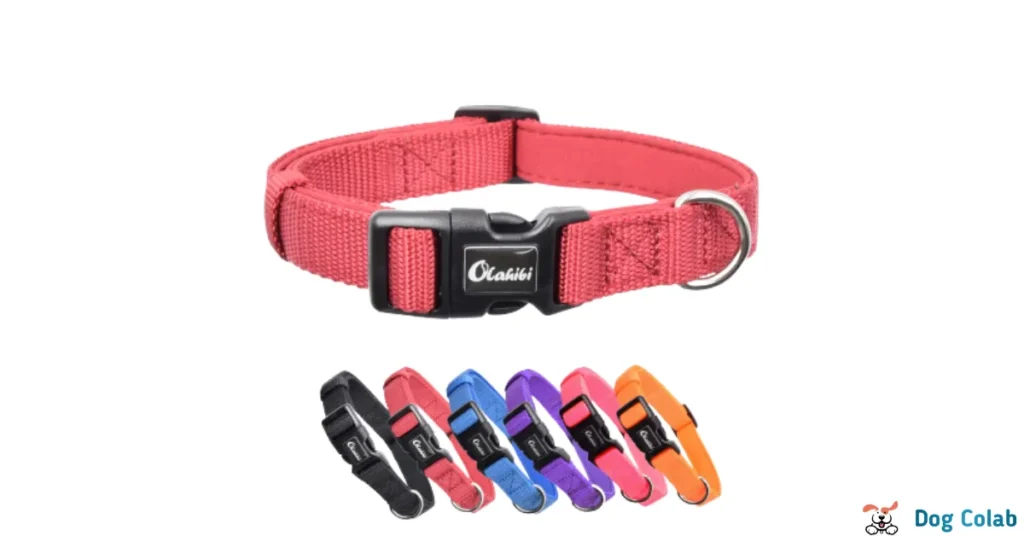
Neoprene collars often have quick-release buckles, making them easy to put collars on and remove. The material’s flexibility ensures a comfortable fit, reducing the risk of irritation or chafing.
Pros
- Water-resistant.
- Durable and comfortable for dogs.
- Suitable for dogs who play in water activities and wet environments.
Cons
- These collars can become smelly if not properly cleaned.
5. Fabric Dog Collar
Some collars are made from fabric materials like cotton or polyester. They are lightweight and can be comfortable for dogs to wear. Fabric collars come in featuring colorful patterns and designs.
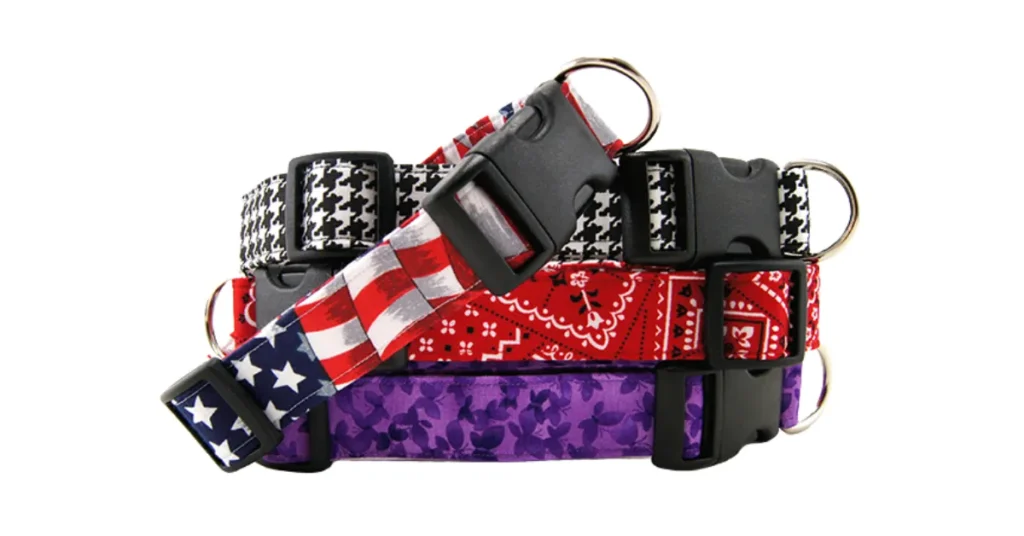
Fabric collars might not be as durable as nylon or leather materials, and they can become soiled or damaged more easily, especially if your dog is active outdoors.
Pros
- Offers a wide range of patterns and styles.
- Lightweight and comfortable.
- Can be machine-washed.
Cons
- Less durable than materials like nylon or leather.
- May not withstand heavy pulling or outdoor activities.
6. Hemp
Hemp collars are eco-friendly and biodegradable. They are soft and comfortable, making them a good choice for dogs with sensitive skin. They come in various natural colors and patterns.
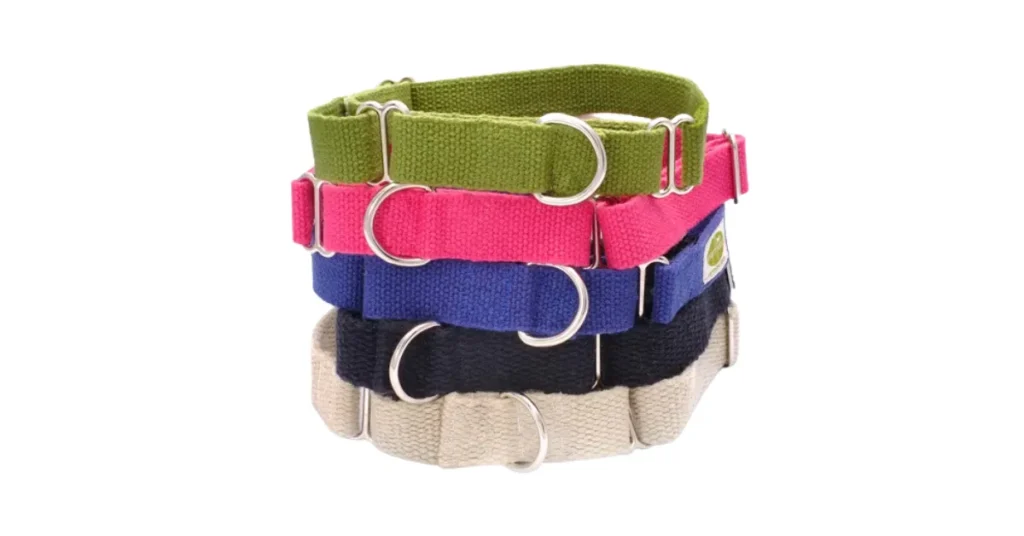
Hemp collars may not be as durable as some other materials, especially if your dog is particularly active.
Pros
- Eco-friendly and sustainable.
- It is hypoallergenic and suitable for dogs with sensitive skin.
- Durable and strong.
Cons
- This can be stretched out.
You may also be interested in:- What is a quick-release dog collar.
What Is the Most Comfortable Material For Dog Collar?
The most comfortable materials for dog collars are neoprene and leather. Neoprene is a soft and flexible synthetic material that molds comfortably to a dog’s neck, making it ideal for dogs with sensitive skin. It’s water-resistant and offers a cushioned feel, which can prevent chafing and irritation.

Leather, particularly high-quality leather, becomes more comfortable over time as it softens and conforms to the dog’s neck shape. It provides a natural and breathable option, making it suitable for dogs prone to skin sensitivities.
Both neoprene and leather offer a balance between comfort and durability, ensuring that your furry companion can wear their collar comfortably throughout various activities.
How to Choose a Dog Collar?
Choosing the best type of dog collar material involves considering your dog’s size, breed, personality, activities, and any specific needs they might have. Here are steps to help you make an informed decision.

1. Size and Fit
Measure your dog’s neck circumference accurately to ensure a properly fit collar. You should be able to comfortably fit two fingers between the collar and your dog’s neck. Collars that are too tight can be uncomfortable or restrict breathing, while collars that are too loose can easily slip off.
2. Material
Consider your dog’s comfort and any potential allergies or sensitivities. Opt for a material that suits their skin type. Soft materials like neoprene, leather, or fabric can be comfortable for many dogs, while dogs prone to allergies might benefit from hypoallergenic materials like hemp.
3. Activity Level
If your dog is active and spends a lot of time outdoors, a durable and weather-resistant material like nylon or biothane might be suitable. If your dog is a swimmer, a water-resistant material like neoprene is a good choice.
4. Purpose
Determine the primary purpose of the collar. Is it for identification, training, or fashion? A simple nylon collar might suffice for identification, while a training collar might have additional features like a D-ring for leash attachment.
5. Breed and Strength
Consider your dog’s breed and strength. Larger, stronger dogs might benefit from more durable materials and designs that distribute pressure evenly. For example, a wide martingale collar might be appropriate for sighthounds to prevent slipping out.
6. Comfort Features
Look for collars with comfort features like padding or lining to prevent chafing and irritation, especially if your dog has sensitive skin.
7. Buckle Type
Choose a buckle type that suits your preference. Quick-release buckles are easy to put on and take off, while traditional buckles provide extra security.
8. Design and Style
If aesthetics matter to you, choose a collar that reflects your dog’s personality and your own style. There are numerous designs, patterns, and colors available.
9. Adjustability
Opt for a collar with adjustable sizing, especially if you have a growing puppy. This ensures a proper fit collar as your dog grows.
10. Safety Considerations
If your dog is a heavy puller or has a tendency to slip out of collars, consider a harness instead. Additionally, choose collars with reflective elements for enhanced visibility during nighttime walks.
Maintenance and Cleaning Tips
Proper maintenance and cleaning of your dog’s collar are important to ensure its longevity, hygiene, and your dog’s comfort. Here are some tips to help you keep your dog’s collar in good condition.

1. Regular Inspection
Frequently check the collar for signs of wear, damage, or fraying. Make sure that any hardware like buckles and D-rings is secure.
2. Cleaning Frequency
How often you clean the collar depends on your dog’s activities and how dirty the collar gets. As a general guideline, clean it at least once a month, or more frequently if needed.
3. Material-Specific Cleaning
Different collar materials require different cleaning approaches.
- Nylon and Fabric Collars: These collars can usually be machine-washed on a gentle cycle. Use a mild detergent, and ensure the collar is fully dried before putting it back on your dog.
- Leather Collars: Wipe off dirt and grime with a damp cloth. Use a leather conditioner occasionally to keep the leather supple and prevent drying out. Avoid submerging leather collars in water.
- Neoprene Collars: These can be rinsed with water and mild soap. Ensure thorough rinsing and drying to prevent odors.
- Biothane and Plastic Collars: Wipe clean with a damp cloth or rinse with water. These materials are often resistant to dirt and water.
- Hemp Collars: Hand wash the collar with mild soap and water. Hemp can be more sensitive to water, so avoid soaking.
4. Hardware Cleaning
If the collar has metal hardware, like buckles and D-rings, wipe them with a cloth to prevent rust or corrosion.
5. Removing Odors
To remove odors, consider using a pet-safe deodorizing spray or a mixture of water and vinegar. Be sure to rinse and dry the collar thoroughly after using any cleaning solutions.
6. Drying
For mold and mildew to be prevented, proper drying is essential. Hang the collar in a well-ventilated area or lay it flat to dry. Avoid direct sunlight or heat sources that can damage certain materials.
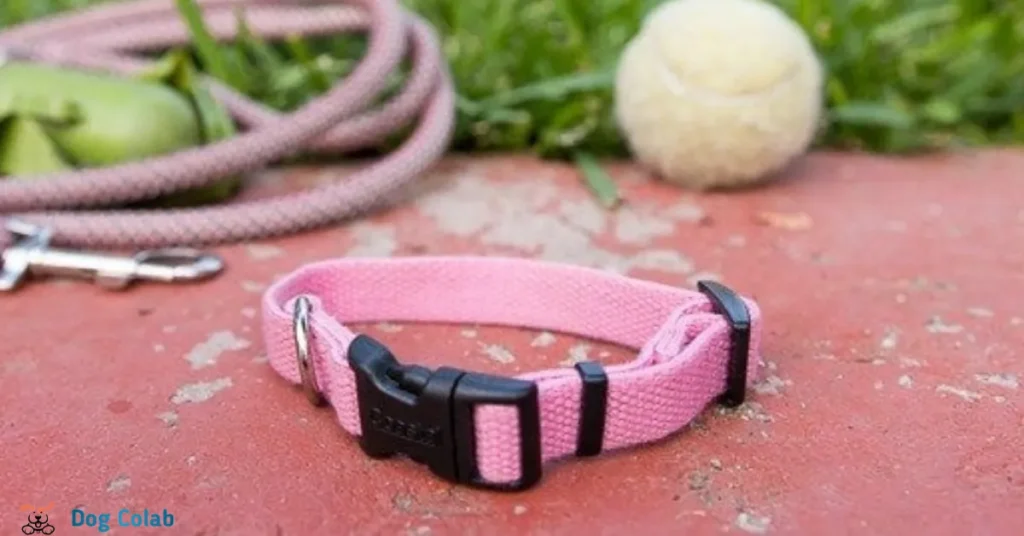
7. Avoid Harsh Chemicals
When cleaning collars, avoid using harsh chemicals or detergents that could irritate your dog’s skin or damage the collar’s material.
8. Label Care
If the collar has ID tags or other labels, make sure they are securely attached and readable after cleaning.
9. Rotation
Consider having a spare collar so that you can alternate between them. This gives each collar a chance to dry thoroughly between uses and extends its lifespan.
Recommended Also Read:- How many collars should a dog have.
Conclusion “What Is the Best Material For Dog Collar”
Choosing the right material for your dog’s collar is essential for their comfort, safety, and overall well-being. Consider your dog’s size, breed, activity level, and any potential skin sensitivities when making your decision.
Nylon collars offer affordability and versatility, while leather collars provide classic style and comfort. Biothane collars combine the benefits of both leather and nylon, making them ideal for active dogs.
Remember to avoid using chain collars for everyday wear and instead opt for martingale collars for gentle control during training.
NOTE:- More information can be found by clicking this link.
FAQs
1. What dog collar material is easy to clean?
Waterproof dog collars often use PVC- or TPU-coated nylon/polyester, easy to clean. Some feature rubber and nylon blends to repel moisture, maintaining cleanliness and durability.
2. Are nylon dog collars waterproof?
Yes, nylon dog collars with PVC-based coating are waterproof, odor-proof, and easy to clean. They’re suitable for beach trips and outdoor activities, maintaining their quality with simple wiping.
3. What lasts longer nylon or leather?
Nylon dog collars generally last longer than leather ones due to their durability and resistance to moisture and wear.
4. What material is more durable than leather?
Polyester is generally more durable than leather for items like dog collars. Its synthetic fibers are resistant to wear, spills, and damage, making it a suitable choice, especially for pets.
